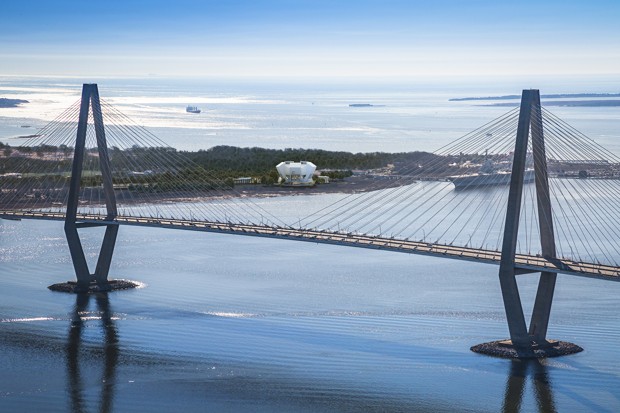City Lab, Jolee Edmondson, July 12, 2018
The National Medal of Honor Museum Foundation was shocked earlier this year when its Moshe Safdie-concieved proposal was rejected by a local planning commission for being too tall.
In late January, the National Medal of Honor Museum Foundation was shocked when the planning commission in the Charleston suburb of Mount Pleasant, South Carolina, unanimously denied its Safdie-concieved proposal because it would exceed by 75 feet the elevation limit on land zoned for no more than 50 feet. The decision was forwarded to town council for review with a recommendation to disallow. Suddenly this picturesque community, defined by shrimp boats and sprawling marshes, was steeped in controversy over the fate of a hugely significant edifice with limitless potential as a tourist attraction.
The planned site for the museum is Mount Pleasant’s Patriots Point, a military-themed landmark abutting Charleston Harbor that spotlights the USS Yorktown, a mammoth World War II aircraft carrier with a storied history. Safdie’s concept revolved around a 90,000-square-foot concrete and glass pentagon, tinted gray-blue to complement the Yorktown. Gallery and exhibition spaces would surround a dramatic daylit great hall. The museum would showcase the heroic deeds of the nation’s approximately 3,500 Medal of Honor recipients, from the Civil War to the War in Afghanistan.

The town council resented what it perceived as the foundation’s “my way or the highway” attitude, reiterating that it must comply with the height ordinance. Expressing a sincere desire to have the museum in Mount Pleasant, council voted on April 2 to give the foundation 60 days to make significant changes or come up with something new. Under the leadership of newly appointed CEO Joe Daniels, the foundation opted to withdraw and start over.
Ultimately, it all came down to a lack of communication. What has transpired in Mount Pleasant underscores the importance of builders engaging in community outreach before submitting a formal plan for public property. Safdie’s design was unveiled in 2015, but it was mainly confined to the foundation’s website.
Daniels, whose background is highlighted by his nearly 12-year tenure as president and CEO of the National September 11 Memorial & Museum in New York City, has gone a long way in assuaging a contentious impasse, giving his assurance that the foundation has “learned its lesson” and is committed to working closely with Mount Pleasant’s town council and the community at large in creating a revised plan for the museum. A series of public hearings, which will include Safdie, are scheduled over the summer.
“We decided to take a pause so that we could involve all the stakeholders in this project,” Daniels tells CityLab. “I think it’s been less about the height of the museum and more about the community feeling left out. With the planning of the 9-11 memorial, it was clear how crucial community input was. Not only did we meet with major donors and the people who lost loved ones, but we also listened to the concerns of residents in lower Manhattan—how the memorial would impact their lives.” He adds, “We don’t want an Us vs. Them situation. There will be zero surprises this time.”
Actively involved in the foundation’s current dialogue with the Mount Pleasant community, Safdie explains that he is “evolving two radically different plans.” One is a scaled-down version of the original design, while the other is a village-like concept with multiple buildings. “We’re doing a number of studies and looking at options,” he says.
“It has to be site-specific. I don’t do preconceived packages,” says the architect. “The design reflects the museum’s proximity to the Yorktown, whose control tower rises to a comparable height. A building must blend in with the site and local culture.”
Daniels agrees with Safdie about the importance of the museum having a presence that befits the stature of Medal of Honor recipients. “We may request a variance pertaining to height by going through the right channels,” he says. “I know that Moshe’s design will be incredible and iconic.”



